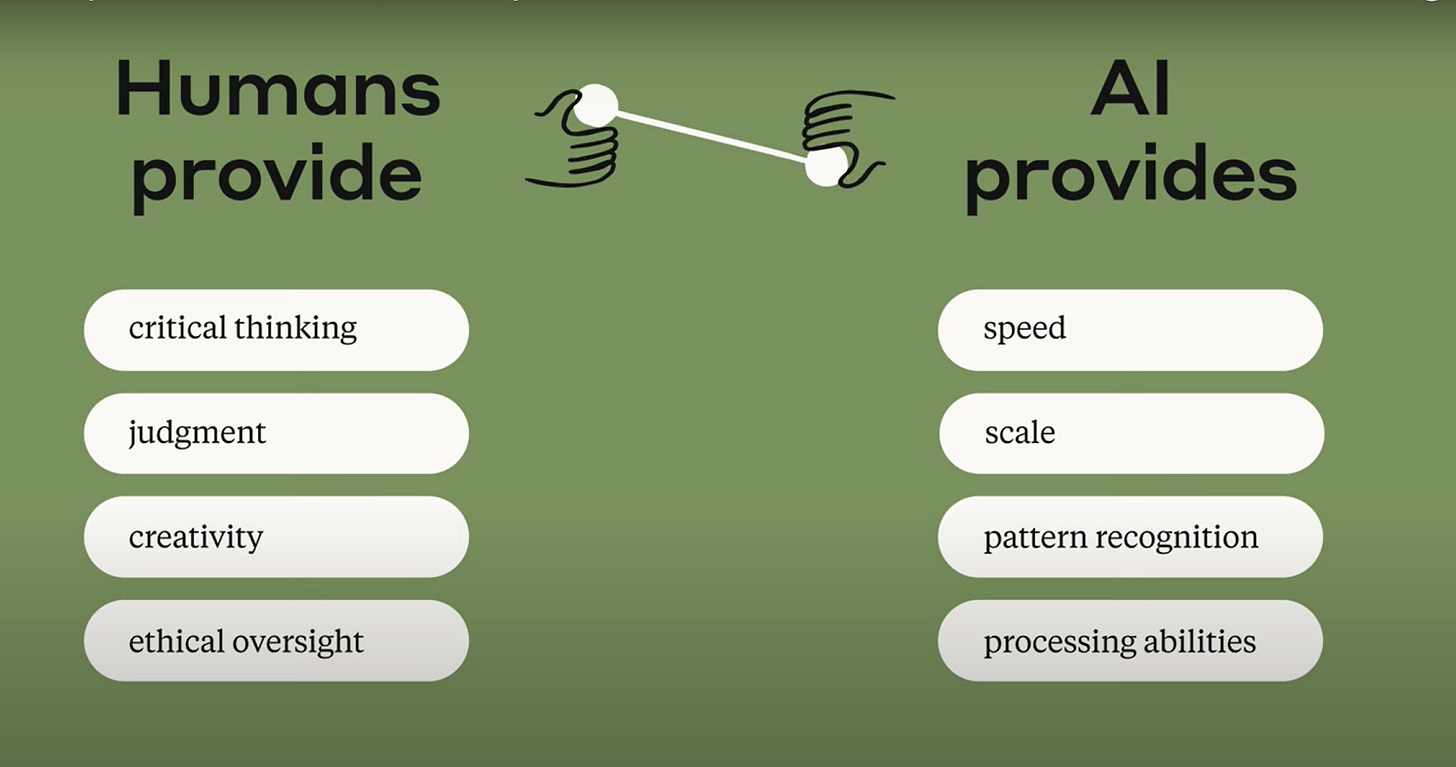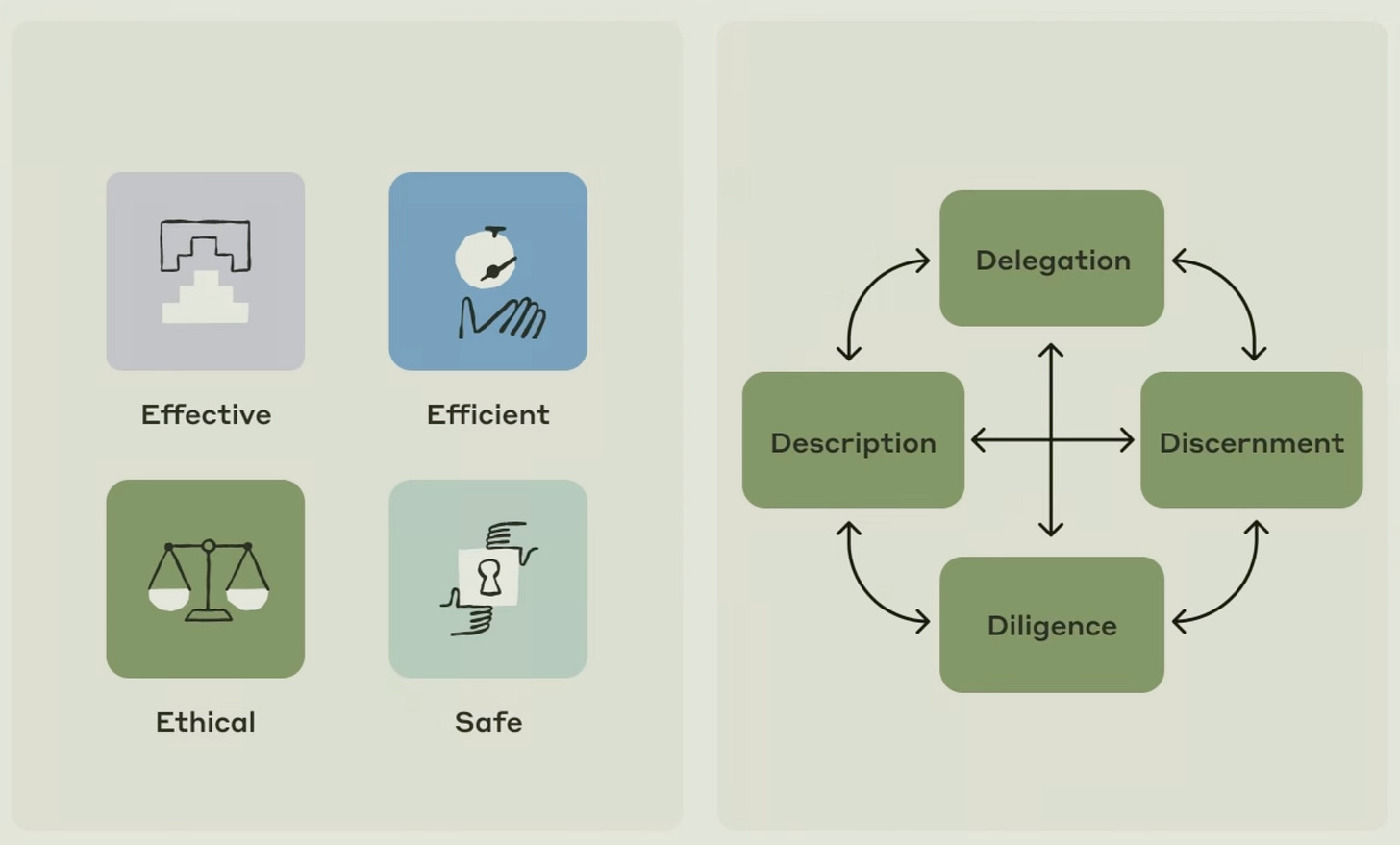Build your AI Fluency using 4Ds Framework
AI Fluency: Framework & Foundations course by Anthropic
Anthropic has published a 4Ds Framework to enhance AI Fluency. Anthropic defines AI Fluency as the ability to work with AI systems in ways that are effective, efficient, ethical, and safe. In essence, AI Fluency is the model for human-AI interaction, and the 4Ds are the competencies required to build AI fluency. As AI tools become more powerful and pervasive, this simple framework aims to establish a baseline for how to think about and interact with AI responsibly.
As AI solutions are being increasingly used to communicate, create, learn, and solve problems, the 4Ds framework is designed to help users engage with AI responsibly across all contexts and applications.
Understanding AI Engagement Modes
To understand how this framework applies across different use cases, it's helpful to examine how people currently engage with AI systems. Anthropic classifies existing AI solutions into three categories based on engagement patterns:
Automation Mode: The AI completes specific tasks based on user instructions and works in automation mode.
Augmentation Mode: AI is used as a brainstorming partner. User and AI collaborate as creative thinking and task execution partners.
Agency Mode: Users configure AI to work independently on their behalf as an agent, establishing its knowledge and behavior patterns rather than just giving it specific tasks.
The 4Ds Framework
Regardless of which mode of AI engagement you choose, the 4Ds Framework provides essential competencies for responsible and effective collaboration. Each competency builds upon the others to create comprehensive AI fluency.
1. Delegation
Delegation involves making thoughtful decisions about what work to do independently, what to do collaboratively with AI, and what to let AI handle autonomously, along with determining how to distribute these tasks effectively. This process begins with problem awareness, which means clearly understanding goals and the nature of the work before involving AI systems. Platform awareness involves understanding the capabilities and limitations of different AI systems to make informed choices about which tools to employ. Task delegation represents the strategic process of thoughtfully distributing work between humans and AI to leverage the unique strengths of each participant. Effective delegation requires both domain expertise and a comprehensive understanding of AI capabilities to create optimal partnerships. The ultimate goal is not to automate everything, but rather to create the most effective human-AI partnership for any given task or objective, ensuring that each participant contributes what they do best to achieve superior outcomes.
2. Description
Effective AI communication centers on creating a productive collaborative environment through three key types of description. Product description involves clearly defining desired outputs, format, target audience, and style preferences. Process description guides how the AI should approach requests, which can be as crucial as specifying the end goal itself. Performance description defines behavioral expectations, such as whether responses should be concise or detailed, challenging or supportive. Rather than treating AI systems as databases or vending machines, successful interaction recognizes them as interactive partners. Clear, upfront communication not only saves time but consistently leads to superior results.
3. Discernment
Discernment represents the ability to thoughtfully evaluate what AI produces, how it produces it, and how it behaves within collaborative interactions. This critical skill encompasses three distinct dimensions: Product discernment focuses on evaluating the quality of actual outputs, assessing factors such as accuracy, appropriateness, coherence, and relevance. Process discernment involves examining how the AI arrived at its output, identifying potential logical errors, attention gaps, or inappropriate reasoning patterns. Performance discernment evaluates how the AI behaves within the collaboration process itself, considering whether its communication style, terminology usage, and responsiveness effectively serve the user's needs. Discernment operates in a continuous feedback loop with Description, creating an iterative process of communication and evaluation. Even the most advanced AI systems benefit significantly from human judgment and oversight, making discernment an essential competency for effective human-AI collaboration. Users can develop this skill by practicing evaluation across all three dimensions, providing specific feedback to AI systems, and leveraging their domain expertise to identify strengths and weaknesses in AI-generated content.
4. Diligence
Diligence encompasses taking responsibility for AI collaborations across three critical dimensions. Creation diligence involves being thoughtful about which AI systems to use and how to engage with them appropriately. Transparency diligence means being honest about AI's role in work with everyone who needs to know, ensuring appropriate disclosure based on context. Deployment diligence requires taking responsibility for verifying and vouching for the outputs that are used or shared with others. Different contexts—whether personal, academic, or professional—may have varying expectations for disclosure and verification standards. Thoughtful application of diligence helps ensure that AI collaborations are not only effective and efficient, but also ethical and safe, creating a foundation for responsible AI use that considers both immediate outcomes and broader implications for stakeholders and society.
Integrated Application
The 4Ds work synergistically to create comprehensive AI fluency. Effective Delegation sets the foundation for appropriate task distribution, while clear Description ensures productive communication. Discernment provides the critical evaluation skills necessary for quality assurance, and Diligence ensures that all AI collaborations remain ethical, transparent, and responsible. Together, these competencies enable users to harness AI's capabilities while maintaining human judgment, oversight, and accountability.
Course Information
This course is developed by Rick Dakan and Joseph Feller, along with the Anthropic team. It's published on Anthropic's LMS Skilljar. You may access the course: AI Fluency: Framework & Foundations here. Additionally you may also read ValueCurve article on the need for frameworks.




